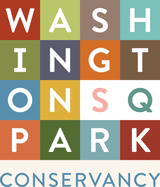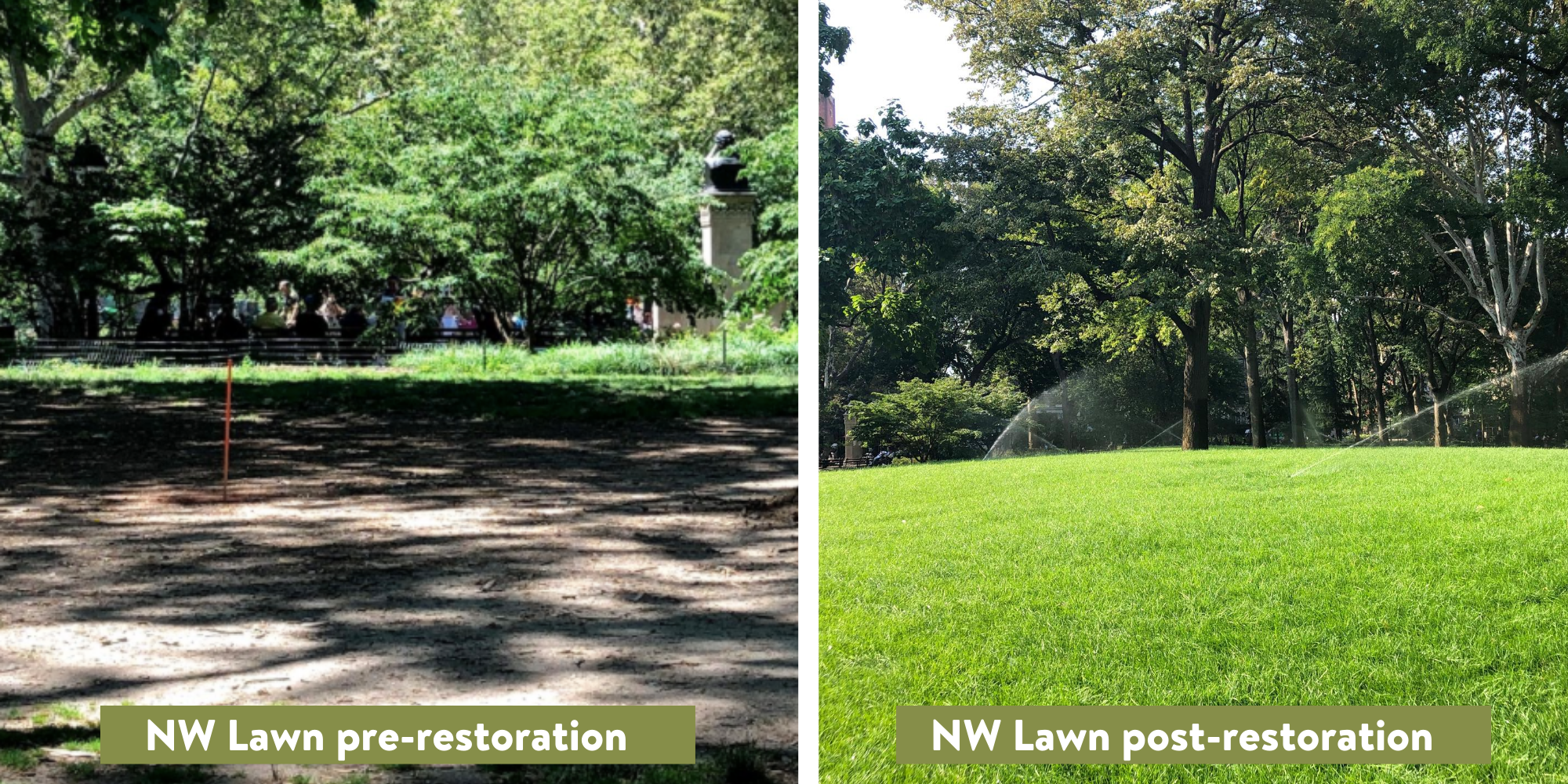Bringing a Landscape Back to Life
At the end of July, the NW lawn of Washington Square Park finally reopened to the public after being closed for over a year to accommodate an extensive restoration. It was a long journey to renew this struggling landscape. As you read about the process from beginning to end, and we hope you gain a new appreciation for the lush grass under your feet.
The Beginning
In the fall of 2017, our growing gardening staff expanded the scope of their care for the Park’s green space, adding long-term maintenance of the lawns such as planning, rotation, and aeration and seeding to their workload. Soon after, gardeners began to identify issues and prioritize lawns most in need of help. To tackle some of the most immediate problems, the Washington Square Park Conservancy (WSPC) purchased grass seed, NYC Parks supplied aerating equipment, and some of the lawns were closed to use for recovery. As this new program progressed, the plight of one particular lawn stood out: the northwest lawn just west of the Arch entrance at Fifth Avenue.
The lawn is the largest in the Park, at approximately 39,000 square feet. And it’s popular: on any given day you’ll see scores of people dotted across the space. Unfortunately, by early 2018, it was in serious trouble that would require more than some seed and a break from use.
During the 2007 renovation the lawn was shaped into its current configuration when a paved asphalt path and curbs were removed, and the small dog run was relocated. Minimal grade changes were made due to the number of trees that were part of the landscape. But the relative openness of the lawn encouraged activities beyond passive use such as picnicking and sunbathing. It became a makeshift gamesfield, dog run, and practice arena. All the use, both active and passive, took a toll on grass, compacting it to such a degree that tree health became a concern.
As the lawn continued to deteriorate, problems continued to grow. Heavy rains washed topsoil onto the paths, further compressing and hardening the exposed earth. Water pooled in a major depression caused by compaction, creating pits of mud that oversaturated the lawn. Large bare spots radiated outward from the middle, giving the space the appearance of a dust bowl. There was a cracked irrigation pipe buried a few feet down. NYC Parks removed several trees due to hazardous conditions, their lifespan most likely shortened by the conditions. What should have been a gleaming emerald became an eyesore that affected that entire section of the Park.
Solving the Problem
As the landscape architect behind the Park’s most recent redesign, George Vellonakis, who served as WSPC Executive Director and Park Administrator during this project, knew what to do. He began by identifying the most pressing issues: compaction and grading. This lawn needed more than just a quick aeration, it needed reshaping to help mitigate the factors that cause compaction in the first place. Using a design and drafting tool called AutoCAD, George virtually redesigned the lawn. With the plans and their approval from NYC Parks in place, the next step was to get estimates from potential landscaping companies. Kelco Landscaping, a company with significant experience with parks across the city and the contractor for Phase II of the most recent renovation at Washington Square, was selected. They fine-tuned the existing plan, making revisions to retain more water onsite. Their professional advice in regards to compaction and grade modifications were essential to the success of the project.
It was now time to figure out how to pay the estimated $170,000 tab. Dozens of options were considered: approaching previously generous foundations, identifying multiple individual donors, possibly even an extended fundraising effort. In the end, simplicity and generosity won out, and from the pool of possibilities emerged a single solution: Dalio Philanthropies.
The Dalio family has supported the Conservancy since 2016. Previously their contributions had gone towards general operating costs in the Park, allowing WSPC to use funding where they felt it was most needed and had the greatest impact. Contributions helped fund needs ranging from a second full-time gardener to balls for the Playground Associate. After a few years of watching their gifts be put to exceptional use, they felt compelled to do more. In November of 2018 Dalio Philanthropies and WSPC met to discuss the project, and the Conservancy later presented them with a formal proposal. By early 2019 they committed to funding the lawn restoration in its entirety.
Work Begins
Work began in June 2019. The lawn was fenced off and surveyed. Specialized machines called compact track loaders that have low ground pressure were brought in for the duration of the job. They have 18-inch rubber tracks that allow them to have a lower PSI (pounds per square inch) than the average human to avoid any further compaction. These machines and their diligent operators got to work. Any topsoil that remained was stripped off and stored away. Stumps were extracted. The soil surrounding the trees was decompacted, giving the roots a chance to finally breathe again.
The ground itself was excavated and the broken water line and damaged sprinkler heads were repaired. Fresh soil was integrated into the lawn to restore the much-needed balance of nutrients, water, and oxygen. Then regrading, overseen by an ISA Certified Arborist, began. Sand and gravel were mixed into soil and shaped into a rolling field. Using this mix instead of plain dirt allows for a free flow of oxygen, water, and nutrients to help mitigate compaction. Next, 6 inches of topsoil, specifically engineered for Washington Square Park’s unique conditions, was blanketed over the sandy base layer. It’s a rich blend of compost, loam, and sand mixed together to suit our particular blend of sunlight, canopy coverage, and heavy use.
The portions of lawn that receive the most sun were carpeted in thick swaths of bright green sod. The rest of the space was filled in with hydroseed; possibly the coolest gardening technique you’ve ever seen. A special slurry is prepared of compost, recycled paper mulch, green coloring, tackifier (basically seed glue), and three different kinds of grass seed that will thrive in that shadier part of the lawn: Kentucky Bluegrass, Fescue, and Rye. It’s a significantly better process than seeding by hand; not just because it’s faster, but because hydroseed has an improved chance at rooting. The fertilizer gives the grass an extra boost. The paper pulp maintains moisture and along with the tackifier protects the seeds from being washed away or eaten by birds and squirrels, although the Park’s smallest critters still managed to eat some. And the green? That’s just for looks.
Reopening
The most active work of the lawn restoration wrapped up in early August 2019, and then it was a matter of remaining patient. The lawn needed to be closed for a full year to give the new grass and sod a chance to fully establish. It’s never easy to keep so much open space cordoned off, especially when the Coronavirus pandemic made every inch of green space essential. But it was a necessary step to ensure that all the hard work and time put into restoring the lawn wasn’t wasted by allowing traffic before it was fully mature.
Finally on July 27, 2020 Head Gardener Guilherme removed the fencing and opened the established lawn for the public to enjoy for all kinds of passive activities. The rolling contours of the lawn now matches the rest of the Park, but this restoration did more than complete a picturesque landscape. The new topography has solved the erosion issues that have plagued the area for years. Now, instead of rainwater and topsoil running off into the sewer system, it drains into the trees and perennial beds near the northwest corner. This makes the Park less of a burden on the sewer system, and it’s also more eco-friendly! As the most western area becomes used again, that positive energy will spread into the surrounding spaces, uplifting that entire quadrant. With the green necklace surrounding the Park complete, Villagers and visitors alike can enjoy the full effect of lush landscapes and pristine hardscapes juxtaposed against one another with a visual impact unlike anywhere else in the world.
Like all lawns, this heavy usage will come at a cost: compaction will always be an issue. Throughout their lives these lawns will need regular maintenance; regrading, re-seeding, rest from use and yes, restoration after time. But the work is well worth it to keep the lawns healthy and thriving.


